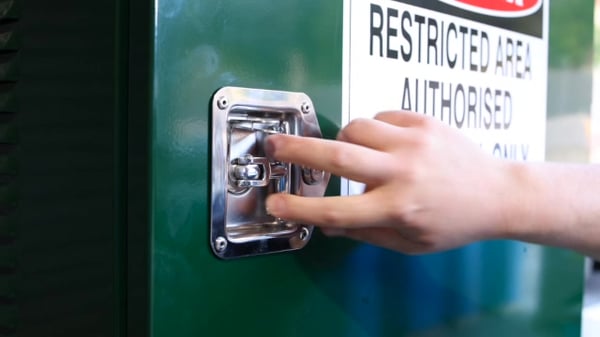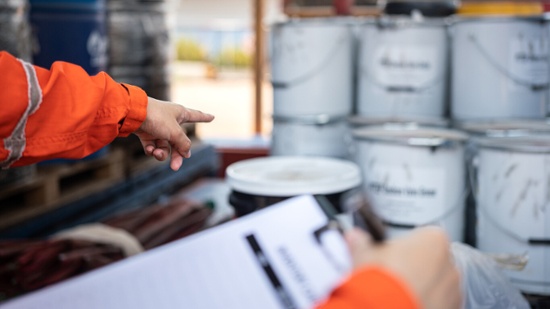Here at Storemasta, we visit the worksites of clients all over Australia— across a broad range of industries. During these dangerous goods storage consultations, we sometimes see the same compliance problem arising again and again. Whether your workplace operates within the agriculture, mining, defence, manufacturing, research, construction, pharmaceutical or chemical sector, we've compiled a list of common chemical compliance problems that we see in HAZCHEM stores.
We hope this post will help you understand how to control hazardous chemicals in your organisation, by ensuring a compliance culture that identifies hazards, controls risk — and actively sustains chemical compliance.
IMPORTANT: Your hazardous substances pose a range of risks to your employees, property and the local environment. Make sure that you have safety data sheets up-to-date and readily available, so you can start to develop procedures and protocols that will ensure significant change in the safety and compliance of your operations.
Compliance Problem #1: Older-Style Safety Cabinets That Are Non-Compliant
During our site inspections, we often see many older-style chemical safety cabinets still being used to store flammables, corrosives, and toxic chemicals. While they may have been been ok to use 15-20 years ago, they no longer meet Australian Safety Standards.

Companies must ensure that their storage equipment is up-to-date with compliance regulations.
One of the problems with these older cabinets is they do not have self-closing doors. When Dangerous Goods like flammable liquids are stored inside safety cabinets, the cabinet must have self-closing, close-fitting doors that are held shut automatically by catches at two or more points. Corrosive and toxic cabinets must also have self-closing doors. Always check the Australian Standard that is relevant to the hazardous chemical being stored within the cabinet.
REMEMBER: A toxic chemical cabinet must be lockable, so if your old safety cabinet has a broken lock (or none at all) the cabinet is no longer compliant.
Compliance Problem #2: Makeshift Cupboards And Shelving For Hazardous Chemicals Or Dangerous Goods Storage
Safety cabinets that conform to Australian Standards use only materials that are compatible with the hazard class of the chemicals inside. Problems we regularly see are filing cabinets, warehouse shelving, and shipping containers recommissioned as chemical stores.
One of the biggest problems here is that the building materials and components may be combustible or otherwise incompatible with the chemicals being stored. At the same time a shipping container or filing cabinet will not have proper ventilation.

Your WHS responsibilities including creating an environment where your employees are healthy and safe, with chemical risks properly controlled.
Sometimes these problems start when your Dangerous Goods quantities begin to increase beyond the capacity of your existing chemical stores. Staff create makeshift storage areas because they don't know where else to put the chemicals.
Before you realise it, 6 months have passed and a makeshift shelf has now become a dedicated store for cleaning chemicals:
“The walls, floor, doors and roof of a cabinet shall either be constructed of corrosion- resistant materials or be protected by a corrosion-resistant lining or coating.” AS3780 - The storage and handling of corrosive substances.
Compliance Problem #3: Incompatible Classes Of Dangerous Goods Stored Together
Many hazardous chemicals and dangerous goods have incompatibility hazards. This means that they can react violently if they come into contact with another substance whose chemical properties clash with their own.
Reactions like fires, explosions, and the release of toxic gases are all dangerous reactions that can occur when incompatible substances are not segregated correctly. Despite being a clear requirement in Australia Safety Standards, we continue to see mixed classes of dangerous goods stored together.
Access your free
It's easy to put something away in the wrong chemical cabinet, and we do recognise that staff make mistakes from time to time.
But very often these hazardous chemical safety issues are due to:
- Inadequate supervision off staff handling hazardous chemicals
- Inadequate or infrequent staff training
- Poor HAZCHEM practices due to lack of knowledge or ambivalence
- Not having dedicated chemical stores for each hazard class
- Missing or incorrect dangerous goods labels and hazard signage
A risk assessment in your chemical and dangerous goods stores can quickly identify high-risk areas and recommend corrective actions or control measures to get the areas compliant.
IMPORTANT: We frequently see corrosive cabinets in the lab carrying both acids and bases on the same shelf. This could be easily resolved by using a chemical cabinet with separate (and fully enclosed) sections, enabling you to safely store acids on one side and bases on the other.
Compliance Problem #4: Crowded and Overloaded Chemical Stores
Storing chemicals properly is a complex issue. It's not just what you store your hazardous chemicals and dangerous goods in that is of importance to compliance and safety, it's how you are using and maintaining your chemical storage facilities.
We often see warning signs of chemical hazards when we inspect dangerous goods stores. One of the key issues that we note is the overloading of chemical stores.
This can put your business at risk of a chemical hazard (such as a flammable liquid from spilled liquids, caused by unstable stacking of drums), which will affect the health and safety of your people - and the surrounding environment.
The problem of overloaded chemical stores can happen on a number of levels.
Here are some hazardous chemical and dangerous goods storage issues that you should avoid:
- Chemicals left outside the stores - eg, unrestrained cylinders sitting outside a gas bottle cage.
- Cabinet exteriors being loaded with items - eg, paint tins, tools, and papers placed on top of chemical cabinets.
- PPE, tools, and other combustible items stored next to chemicals - eg, paint brushes, rags, and rollers stored inside the flammable liquids cabinet next to the paints.
- Overloaded pallets - eg, containers of liquid corrosives stacked on pallets which exceed the capacity of the pallet spill bunds (and are also at risk of collapsing).
- Chemical quantities exceed allowable limits
Buying a compliant safety cabinet is only the first step in maintaining chemical compliance. If you don’t properly train staff on HAZCHEM and dangerous goods safety and don’t have procedures in place so they understand how to use the cabinet, then the controls of the cabinet won’t be effective. Likewise, it’s part of your WHS obligations to maintain your risk controls. Therefore, you must make sure that there are good housekeeping procedures in place, and that your staff are using the cabinet in the correct way.
REMEMBER: To ensure that you’re meeting your safety obligations, refer to the relevant Australian Standard for detailed storage requirements relating to your dangerous goods class — and the use and maintenance of your chemical store.
Creating a Better Compliance Culture
Even when they aren't being used, hazardous chemicals are still a risk to the health and safety of your workers. It's vital that you can accurately assess We recommend carrying out a risk assessment on your chemical stores to ensure they meet the requirements of relevant Australian Safety Standards. To help you to do this, download our free eBook How to manage the risk of Hazardous Chemicals in the workplace which clearly explains what to do.
Joining the team as a Dangerous Goods Storage Consultant, Melissa Hampton became Storemasta's Marketing Manager in late 2021. With extensive knowledge and experience in chemical compliance, Melissa is responsible for leading the Marketing team and helping shape their marketing strategy. In her spare time, you can find Melissa hiking, swimming and enjoying the great outdoors in beautiful north-west Tasmania.
